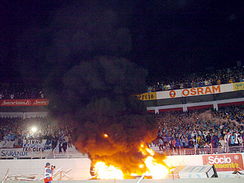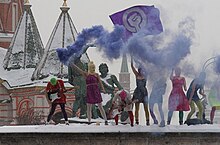Hooliganism
This articleneeds additional citations forverification.(May 2007) |

Hooliganismis disruptive or unlawful behavior such asrioting,bullyingandvandalism,often in connection withcrowdsatsportingevents. Ahooliganis a person that engages in illicit reckless behaviors and is apublic nuisance.
Etymology
[edit]There are several theories regarding the origin of the wordhooliganism,which is a derivative of the wordhooligan.The Compact Oxford English Dictionarystates that the word may have originated from the surname of a rowdyIrishfamily in amusic hallsong of the 1890s.[1][2]Clarence Rook,in his 1899 bookHooligan Nights,wrote that the word came from Patrick Hoolihan (or Hooligan), an Irishbouncerand thief who lived inLondon.In 2015, the BBC Scotland TV programmeThe Secret Life of Midges[3]noted that the English commander-in-chief during theJacobite rising of 1745,General Wade,misheard the local Scots Gaelic word formidge—meanbh-chuileag—and coined the wordhooliganto describe his fury and frustration at the way the tiny biting creatures made the life of his soldiers and himself a misery; this derivation may beapocryphal.
Early usage
[edit]The word first appeared in print in Londonpolice courtreports in 1894 referring to the name of a gang of youths in theLambetharea of London—theHooligan Boys,[4]and later—theO'Hooligan Boys.[5]
In August 1898 the murder of Henry Mappin in Lambeth committed by a member of the gang drew further attention to the word which was immediately popularised by the press.[6]The London newspaperThe Daily Graphicwrote in an article on 22 August 1898, "The avalanche of brutality which, under the name of 'Hooliganism'... has cast such a dire slur on the social records ofSouth London."[2][7]
The inquest was carried out byMr Braxton Hickswho "remarked that the activity of the gang he referred to was not confined to Lambeth, but extended to numerous other districts. It was composed of young fellows who scorned to do a stroke of work, and obtained a living by blackmailing. It was a common practice for three or four of these men to walk into a shop and offer the shopman the alternative of giving them a dollar for drink or having his shop wrecked. In connection with the Oakley-street tragedy intimidation had reached an unexampled case. Witnesses had been warned that it would be as much as their life was worth to give evidence against John Darcy. On Wednesday plain-clothes men escorted the witnesses from the court singly. He himself had been warned — not by anonymous letter but through a mysterious personal medium — that if seen in a certain neighbourhood he would be done for. A magistrate had also told him that he had been the recipient of a like indignity."[8][9]
Arthur Conan Doylewrote in his 1904 short story "The Adventure of the Six Napoleons","It seemed to be one of those senseless acts of Hooliganism which occur from time to time, and it was reported to the constable on the beat as such. "H. G. Wellswrote in his 1909 semi-autobiographical novelTono-Bungay,"Three energetic young men of the hooligan type, in neck-wraps and caps, were packing wooden cases with papered-up bottles, amidst much straw and confusion."[7]
According toLifemagazine (30 July 1951), the comic strip artist and political cartoonist Frederick Burr Opper introduced a character calledHappy Hooliganin 1900; "hapless Happy appeared regularly in U.S. newspapers for more than 30 years", a "naive, skinny, baboon-faced tramp who invariably wore a tomato can for a hat."Lifebrought this up by way of criticizing the Soviet U.N. delegate Yakov A. Malik for misusing the word. Malik had indignantly referred to anti-Soviet demonstrators in New York as "hooligans". Happy Hooligan,Lifereminded its readers, "became a national hero, not by making trouble, which Mr. Malik understands is the function of a hooligan, but by getting himself help."
Modern usage
[edit]Later, as the meaning of the word shifted slightly, none of the possible alternatives had precisely the same undertones of a person, usually young, who belongs to an informal group and commits acts of vandalism or criminal damage, starts fights, and who causes disturbances but is not a thief.[7]Hooliganism is nowpredominately[failed verification]related to sport.[10]
Violence in sports
[edit]
The wordshooliganismandhooliganbegan to be associated withviolence in sports,in particular from the 1970s in the UK withfootball hooliganism.The phenomenon, however, long preceded the modern term; for example, one of the earliest known instances of crowd violence at a sporting event took place in ancientConstantinople.Twochariot racingfactions, the Blues and the Greens, were involved in theNika riotswhich lasted around a week in 532 CE; nearly half the city was burned or destroyed, in addition to tens of thousands of deaths.[11]
Sports crowd violence continues to be a worldwide concerning phenomenon exacting at times a large number of injuries, damage to property and casualties. Individual, contextual, social and environmental factors interact and influence one another through a dynamic process occurring at different levels.[12]Macro-sociological accounts suggest that structural strains, experiences of deprivation or a low socio-economic background can at times be instrumental to the acceptance and reproduction of norms that tolerate great levels of violence and territoriality, which is a common feature of football hooliganism.[13]Furthermore, social cleavages within societies facilitate the development of strong in-groups bonds and intense feelings of antagonism towards outsiders which in turn can facilitate group identification and affect the likelihood of fan violence.[13]
In British sports
[edit]This section should include a summary ofFootball hooliganism in the United Kingdom.(August 2019) |
Beginning in at least the 1960s, the United Kingdom gained a reputation worldwide forfootball hooliganism;the phenomenon was often dubbed theBritishorEnglish Disease.[14][15][16][17][18][19][excessive citations]However, since the 1980s and well into the 1990s the UK government has led a widescale crackdown on football related violence. While football hooliganism has been a growing concern in some continental European countries in recent years, British football fans now tend to have a better reputation abroad. Although reports of British football hooliganism still surface, the instances now tend to occur at pre-arranged locations rather than at the matches themselves.
In American sports
[edit]Football (soccer) and other sports hooliganism overall is rare in the United States in part because of stricter legal penalties forvandalismand physical violence, club markets having their own territory of fans, venues banning weapons, stricter security during games, and a strongertabooon politics, class, race, and religion into the American sporting culture. Although isolated drunken fights at games do occur, they rarely escalate to major brawling comparable toEuropeandLatin America.[20]
In the Soviet Union and Russia
[edit]
In theSoviet Unionthe wordkhuligan(Russian:хулиган– transliteration of the English word) was used to refer toscofflaws.Hooliganism (Russian:хулиганство,khuliganstvo) was listed as a criminal offense, similar todisorderly conductin some other jurisdictions, and used as a catch-all charge for prosecuting unapproved behavior.[2][21]
Olympic medalistVasiliy Khmelevskiywas convicted of hooliganism for setting a costumed person on fire during a celebration inMinskin 1979 and sentenced to five years of imprisonment.[22]Mathias Rustwas convicted of hooliganism, among other things, for his 1987 Cessna landing onBolshoy Moskvoretsky Bridgenext toRed Square.
Since the fall of the Soviet Union, nowadays, hooliganism is defined generally in theCriminal Code of Russiaas an average gravity crime.[23]
More recently, the same charge has been leveled against members of the feminist punk groupPussy Riotfor which three members each received a two-year sentence on 17 August 2012. Hooliganism charges were also levelled against theGreenpeace protestersin October 2013.[24]In March 2022,Marina Ovsyannikova,a Russian journalist who held up a banner protesting theRussian invasion of Ukraineduring a national news broadcast, was convicted of floutingRussian anti-protest lawsand fined₽30,000 for her actions.The Kremlincalled her actions an act of hooliganism.[25]
In film
[edit]- A Clockwork Orange(1971)
- The Asphalt Jungle(1950)[26]
- Awaydays(2009)
- Cass(2008)
- Eden Lake(2008)
- EuroTrip(2004)
- The Firm(1988)
- The Firm(2009)
- The Football Factory(2004)
- Green Street(2005)
- Green Street 2: Stand Your Ground(2009)
- Green Street 3: Never Back Down(2013)
- I.D.(1995) andID2: Shadwell Army(2016)
- Neds(2010)
- Rise of the Footsoldier(2007)
- Tash Force(2011)
- Training Day(2001)
See also
[edit]- Collective effervescence
- Crowd psychology
- Disorderly conduct
- Breach of the peace
- Football hooliganism
- Juvenile delinquency
- Violent disorder
- List of hooligan firms
- List of violent spectator incidents in sports
References
[edit]- ^"hooligan".Compact Oxford English Dictionary.Oxford English Dictionary.Retrieved15 October2008.[dead link]
- ^abcHarper, Douglas."hooligan".Online Etymology Dictionary.Retrieved15 October2008.
- ^Scotland, BBC."The Secret Life of Midges".BBC website.BBC.Retrieved23 October2015.
- ^"Who were the original Hooligans?".Daily News.quezi.com. 24 April 1894. Archived fromthe originalon 3 January 2010.Retrieved12 March2009.
- ^"Who were the original Hooligans?".Reynolds Newspaper.quezi.com. 29 April 1894. Archived fromthe originalon 3 January 2010.Retrieved12 March2009.
- ^"Who were the original Hooligans?".The Penny Illustrated Paper and Illustrated Times.quezi.com. 13 August 1898. Archived fromthe originalon 3 January 2010.Retrieved12 March2009.
- ^abcQuinion, Michael (27 June 1998)."Hooligan".World Wide Words.Retrieved30 June2010.
- ^"REIGN OF TERROR IN SOUTH LONDON. OAKLEY STREET MURDER. WITNESSES THREATENED".Lloyd's Weekly Newspaper.24 July 1898 – via British Newspaper Archive.
- ^"LAMBETH TRAGEDY. THE ARREST IN THE STRAND. ONE OF" HOOLIGAN'S GANG ".Lloyd's Weekly Newspaper.17 July 1898 – via British Newspaper Archive.
- ^Osman, Gusmusgul; Acet, Mehmet (2016)."The Open Sore of Football: Aggressive Violent Behaviour and Hooliganism".Physical Culture and Sport Studies and Research.71(1): 30–37.doi:10.1515/pcssr-2016-0015.
- ^McComb, David (2 September 2004).Sports in World History (Themes in World History).Routledge. p. 25.ISBN0-415-31812-2.
- ^Nepomuceno, Thyago Celso C.; de Moura, Jadielson Alves; e Silva, Lúcio Câmara; Cabral Seixas Costa, Ana Paula (December 2017). "Alcohol and violent behavior among football spectators: An empirical assessment of Brazilian's criminalization".International Journal of Law, Crime and Justice.51:34–44.doi:10.1016/j.ijlcj.2017.05.001.ISSN1756-0616.
- ^abDunning, E., Murphy, P., Waddington, I., & Astrinakis, A. E. (Eds.). (2002). Fighting fans: Football hooliganism as a world phenomenon. Dublin: University College Dublin Press
- ^Asser, Martin (19 June 2000)."Analysis: Soccer violence an international problem".BBC.Retrieved3 November2020.
- ^"A Day Of Horror And Shame".Sports Illustrated.10 June 1985.Retrieved3 December2020.
- ^"FIG FACT-SHEET FOUR: HOOLIGANISM".Football Industry Group, University of Liverpool. Archived fromthe originalon 13 September 2008.Retrieved20 March2011.
- ^Stott, Clifford; Pearson, Geoff (2007).Football Hooliganism: Policing the War on the English Disease.Pennant Books.ISBN978-1-906015-05-3.
- ^Cacciottolo, Mario (6 April 2007)."The return of the English disease?".BBC.Retrieved20 March2011.
- ^"Another sorry outbreak of the English disease".The Independent on Sunday.London. 17 June 2004. Archived fromthe originalon 11 April 2008.Retrieved20 March2011.
- ^Gallo, D. J. (18 October 2017)."Unfriendly confines: the unsung history of America's low-key hooliganism".The Guardian.ISSN0261-3077.Retrieved14 April2020.
- ^Silverglate, Harvey(2009).Harvey Silverglate on 'Three Felonies a Day'(YouTube). 3 minutes in.Archivedfrom the original on 11 December 2021.Retrieved12 February2013.
- ^"Вечно третий или бронза тоже благородный металл – Популярные статьи – Библиотека международной спортивной информации".BMSI.ru.Retrieved7 February2018.
- ^Johnson, Ben (1 August 2012)."Why Are Pussy Riot's Alleged Crimes Called 'Hooliganism'?".Slate Magazine.
- ^"Greenpeace piracy charges 'dropped'".BBC News.23 October 2013.Retrieved7 February2018.
- ^"Court slaps fine on Russian woman after on-air TV protest".Reuters.15 March 2022.
- ^Becker, Peter Heath."The Asphalt Jungle".The Criterion Collection.Retrieved5 August2015.
